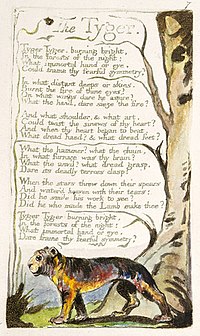A quatrain is a type of stanza, or a complete poem, consisting of four lines.
Fearful Symmetry is a phrase from William Blake's poem "The Tyger". It has been used as the name of a number of other works:
In poetic and musical meter, and by analogy in publishing, an anacrusis is a brief introduction. In music, it is also known as a pickup beat, or fractional pick-up, i.e. a note or sequence of notes, a motif, which precedes the first downbeat in a bar in a musical phrase.

"The Lamb" is a poem by William Blake, published in Songs of Innocence in 1789.

Songs of Innocence and of Experience is a collection of illustrated poems by William Blake. Originally, Blake illuminated and bound Songs of Innocence and Songs of Experience separately. It was only in 1794 that Blake combined the two sets of poems into a volume titled Songs of Innocence and of Experience Shewing the Two Contrary States of the Human Soul. Even after beginning to print the poems together, Blake continued to produce individual volumes for each of the two sets of poetry.
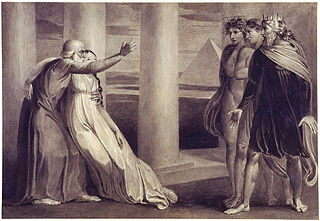
Tiriel is a narrative poem by William Blake, written c.1789. Considered the first of his prophetic books, it is also the first poem in which Blake used free septenaries, which he would go on to use in much of his later verse. Tiriel was unpublished during Blake's lifetime and remained so until 1874, when it appeared in William Michael Rossetti's Poetical Works of William Blake. Although Blake did not engrave the poem, he did make twelve sepia drawings to accompany the rough and unfinished manuscript, although three of them are considered lost as they have not been traced since 1863.
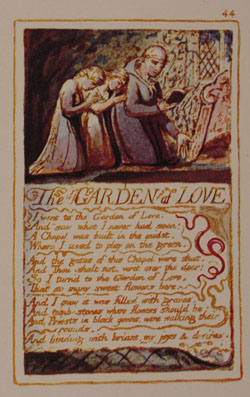
"The Garden of Love" is a poem by the Romantic poet William Blake. It was published as part of his collection, Songs of Experience.

Earth's Answer is a poem by William Blake within his larger collection called Songs of Innocence and of Experience. It is the response to the previous poem in The Songs of Experience-- Introduction . In the Introduction, the bard asks the Earth to wake up and claim ownership. In this poem, the feminine Earth responds.
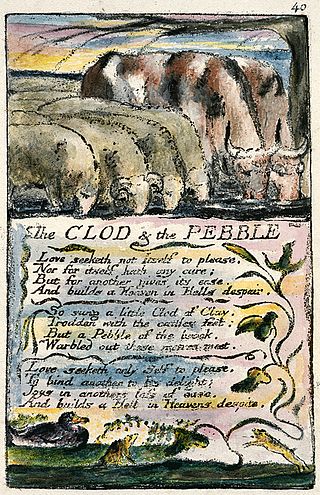
"The Clod and the Pebble" is a poem from William Blake's 1794 collection Songs of Innocence and of Experience.

The Little Girl Lost is a 1794 poem published by William Blake in his collection Songs of Innocence and of Experience. According to scholar, Grevel Lindop, this poem represents Blake's pattern of the transition between "the spontaneous, imaginative Innocence of childhood" to the "complex and mature adult state of Experience."
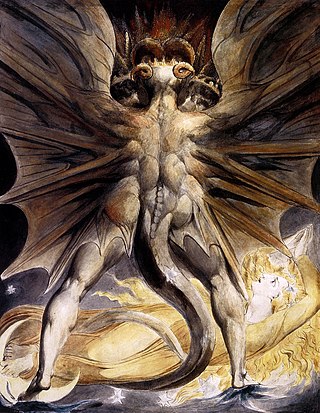
William Blake's body of work has influenced countless writers, poets and painters, and his legacy is often apparent in modern popular culture. His artistic endeavours, which included songwriting in addition to writing, etching and painting, often espoused a sexual and imaginative freedom that has made him a uniquely influential figure, especially since the 1960s. After Shakespeare, far more than any other canonical writer, his songs have been set and adapted by popular musicians including U2, Jah Wobble, Tangerine Dream, Bruce Dickinson and Ulver. Folk musicians, such as M. Ward, have adapted or incorporated portions of his work in their music, and figures such as Bob Dylan, Alasdair Gray and Allen Ginsberg have been influenced by him. The genre of the graphic novel traces its origins to Blake's etched songs and Prophetic Books, as does the genre of fantasy art.

"The Shepherd" is a poem from William Blake's Songs of Innocence (1789). This collection of songs was published individually four times before it was combined with the Songs of Experience for 12 editions which created the joint collection Songs of Innocence and of Experience (1794). Blake produced all of the illuminated printings himself beginning in 1789. Each publication of the songs has the plates in a different order, and sixteen other plates were published posthumously.
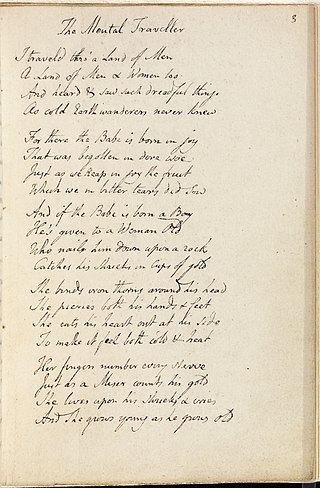
The Mental Traveller is a poem by William Blake. It is part of a collection of unpublished works called The Pickering Manuscript and was written in a manner that suggests the poem was to be read directly from the collection.

Her Fearful Symmetry is a horror novel by the American writer Audrey Niffenegger. The book was published on October 1, 2009 and is set in London's Highgate Cemetery where, after a year of research for the book, Niffenegger acted as a tour guide.

"On Another's Sorrow" is a poem by the English poet William Blake. The poem discusses human and divine empathy and compassion. It was published as part of the Songs of Innocence and of Experience in 1789 as the last song in the Songs of Innocence section.
"The Fly" is a poem written by the English poet William Blake. It was published as part of his collection Songs of Experience in 1794.
"Night" is a poem in the illuminated 1789 collection Songs of Innocence by William Blake, later incorporated into the larger compilation Songs of Innocence and of Experience. "Night" speaks about the coming of evil when darkness arrives, as angels protect and keep the sheep from the impending dangers.

Spring is a lyric poem written and illustrated by William Blake. It was first published in Songs of Innocence (1789) and later in Songs of Innocence and Experience (1794).
A Charm of Lullabies, Op.41 is a song cycle for mezzo-soprano with piano accompaniment by Benjamin Britten. It consists of five songs composed on poems by William Blake, Robert Burns, Robert Greene, Thomas Randolph and John Phillip. It was written in 1947 for Nancy Evans, who gave the first performance with Felix de Nobel (piano) at a festival in The Hague 3 January 1948. The score was first published in 1949 by Boosey and Hawkes in London.

"The School Boy" is a 1789 poem by William Blake and published as a part of his poetry collection entitled Songs of Experience. These poems were later added with Blake's Songs of Innocence to create the entire collection entitled "Songs of Innocence and of Experience Shewing the Two Contrary States of the Human Soul". This collection included poems such as "The Tyger", "The Little Boy Lost", "Infant Joy" and "The Shepherd". These poems are illustrated with colorful artwork created by Blake first in 1789. The first printing in 1789 consisted of sixteen copies. None of the copies of Songs of Innocence are exactly alike as some of them are incomplete or were colored in posthumously "in imitation of" other copies.
